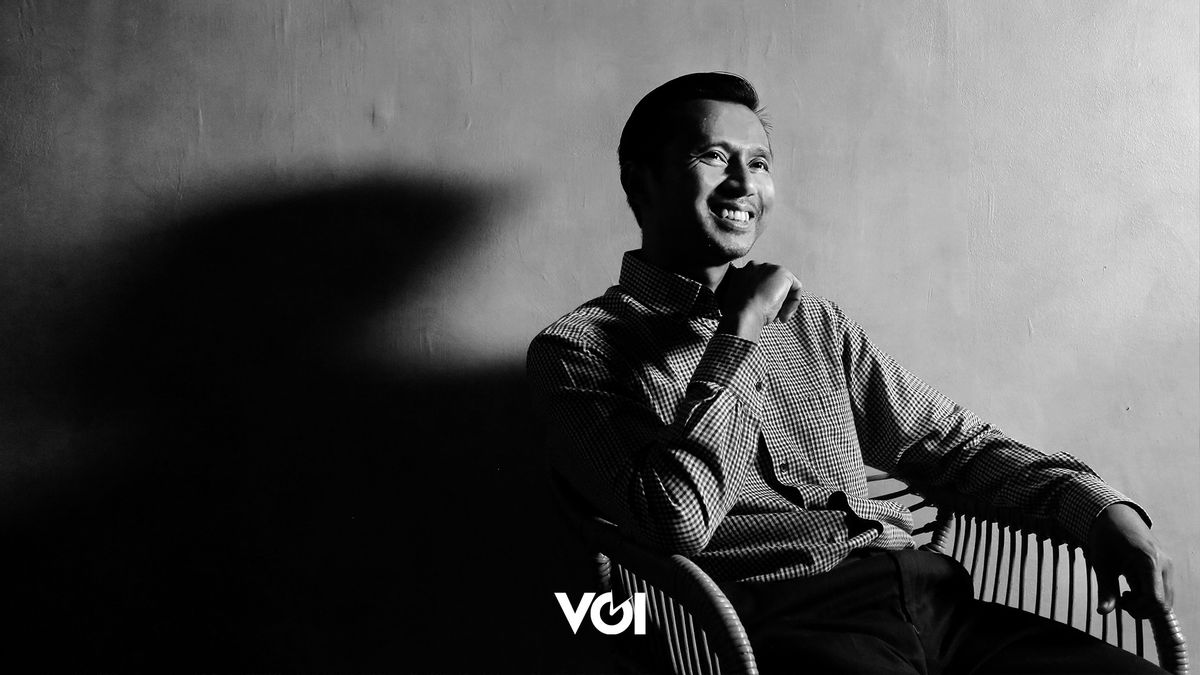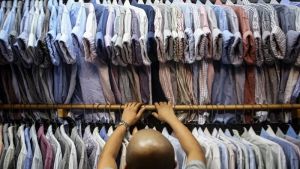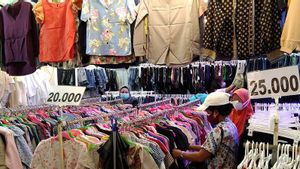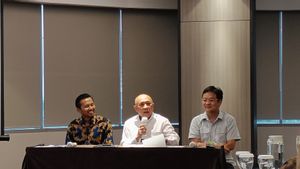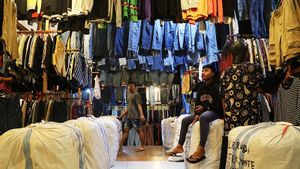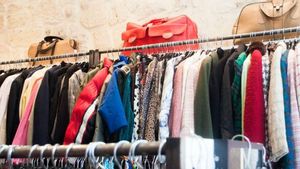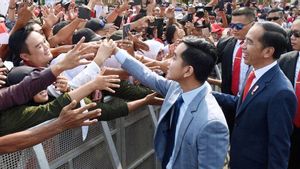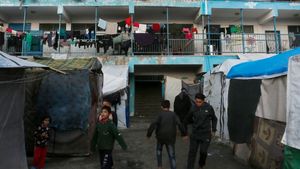The import of used clothes becomes a problem when there are too many of them. President Jokowi also ordered that this action be stopped because it had an effect on the national garment industry. However, in the view of the General Chairman of the Indonesian Fiber and Filament Yarn Producers Association (APSyFI) Redma Gita Wiraswasta, there has been no serious effort to stop the import of used clothing. What has been done is at the merchant level, while the importers have not been prosecuted.
***
In fact, the import of used clothes has been going on for a long time. However, lately, there have been too many of them and they have threatened the national garment industry from upstream to downstream. "I have ordered them to look for it properly and every day or two, they have found so many. It is disrupting the domestic textile industry," said President Jokowi after attending the inauguration of the opening of "Business Matching" of Domestic Products 2023 in Jakarta Wednesday, March 15.
In the data owned by Redma Gita Wiraswasta in 2022, there are around 320,000 tons of illegal used goods imported. Of that amount, used clothes are around 30 percent. This means that there are about 100,000 tons. "Before 2018 the number was only around 5 to 10 percent of the total imports of used goods. Because if it's only a little, we do not mind. And that's for the poor," he said.
However, recently the middle class has been buying imported second-hand clothes. “After thrifting became a way of life, the middle class also joined in. The amount reaches 100,000 tons, about 500 to 600 thousand bales per year, this is disrupting. The peak will occur in semester 2 of 2022," continued Redma.
According to Redma, the current prohibition measures are still at the merchant level. “This is a bitter choice to make. Actually, those who enjoy it are importers. They are the ones who must be held accountable. So if you talk at the merchant level, it won't be finished. The importer should be handled,” said Redma.
The flood of imports of used clothing also has an impact on clothing sales in the 2023 Eid season. "Normally, sales increase by 100 percent, but now we are being attacked by the entry of imported used clothing. It can go up 15 to 20 percent, which is good. We once again ask the government to seriously address this. What we ask is not adventurous, we ask the government to be fair. If imported goods enter properly, meaning that you pay VAT and other import duties, we are ready to compete. The problem is from downstream to upstream we pay VAT. That is what we are fighting for that is unfair," he told Iqbal Irsyad, Edy Suherli, Savic Rabos, Rifai, and Irfan Medianto at the VOI Media office, Tanah Abang III Street No 23A, Central Jakarta, recently. Here is the full excerpt.

According to the Head of APSyFI, Redma Gita Wiraswasta, the current enforcement is only at the merchant level, it should be the importers who are being prosecuted. (Photo by Savic Rabos, DI Raga VOI)
The phenomenon of importing used clothes has been around for a long time, but only recently has it become a national issue. How do you see this?
Since 20 years ago, imports of used clothing have actually existed. Only now it's getting massive. Regulations regarding the import of used clothing have existed since 2015 but these regulations have never been enforced. In the past, when there were not many, it was normal, but after more and more, the situation started to interfere with our garment industry.
How much is the import value of used clothes each year?
Our calculations are that in 2022 there will be around 320,000 tons of illegal used goods imported. For used clothes, there is about 30 percent of it. Before 2018 it was around 5 to 10 percent of the total used goods imports. Because a little we do not fuss. And that's for the poor.
But after thrifting became a lifestyle, the middle class also joined in. And the amount reaches 100,000 tons, around 500 to 600 thousand bales per year, this is disturbing. This will happen in the 2nd half of 2022.
How can it be like that?
Because used clothing has changed the way it enters. Please confirm with Customs and Excise for this. In the past, they used to enter using small boats through the people's harbor on the coast of Sumatra, now they use containers. If it's already with the container, the entry is no longer at the port of the people. He will enter through a major port, although not the main port.
Because the amount is very large, it has disrupted our garment industry from downstream to upstream. Downstream, they directly sell used clothes to consumers. There is more than 80 percent of our clothing manufacturers or IKM (small and medium industries) are affected. They are unable to compete with imported used clothes.
If IKM is helpless, what will be the next impact?
In the structure of our garment industry, the large ones are usually export-oriented, while the small ones are IKM. They target the domestic market. IKM is helpless in dealing with a large number of imported used clothes everywhere. When IKM is disrupted, the entire production chain will also be disrupted. That is why the import of used clothing must be controlled.
You are from the fiber and yarn association, which incidentally is in the upstream garment sector, are you also disrupted by this?
When the downstream garment sector is disrupted, we in the upstream sector are also disrupted. The destructive power of this used imported clothing is enormous. From downstream to upstream, even the petrochemical industry is also affected.

If the disturbance is nominalized, how big is the loss?
I have never calculated that in detail, but just a rough estimate from the import of illegal used goods of more than 300,000 tons, the state loss could be as much as IDR 19 trillion. If normal imports include VAT, import duties, and other things, now there is absolutely no income to the country.
The total value of used clothing comes in around 100,000 tons, if we compare it, it can create around 150,000 workers from the downstream to upstream sectors. So the loss is already that massive from the presence of these imported used clothes in the domestic garment industry. It has not been included how much foreign exchange is spent to buy these imported clothes from abroad.
So there is a lot of domino effects?
When it comes to the domino effect, other sectors will also be affected, such as logistics, retail, and other sectors such as the economic sector around factories, there are small shops, and traveling merchants also affected.
This illegal import of used clothes, what is the point of importing legal clothes?
Indeed, the Ministry of Trade can issue imports of used materials for recycled products such as gloves. It is only for certain companies which are strictly monitored. And the material can indeed be recycled. It is difficult to recycle used clothes that are sold in the market today.
Talking about thrifting, some say it is environmentally friendly because there is the reuse of clothes that have been used (reused), how do you see this?
From an environmentally friendly perspective, I think it's still debatable. This is to counter past fashion trends. So they throw away their past fashion trends here. The government bans imports of used clothing first; based on health considerations. Second, from an environmental point of view, of the many that enter, how much can the market absorb. From the used clothing centers in Senen, Gedebage, Blok M, and Slipi, there are still lots of stocks from 3 years ago that have not been sold. If you don't sell it, it will mold and become trash. And the third is the ban because the economic impact is massive.
Merchants already have a stock of goods, suddenly asked to stop or destroy it, how do you see it?
This is also a problem in itself, those who sell are also SMEs. But this is a bitter choice to make. Actually, those who enjoy it are used clothing importers. That must be held accountable. So if you talk at the merchant level, it won't be finished. The importer should be handled. And if you want, the government can do that.
Because the importers are already using containers, so are they doing it seriously?
Many parties are involved in the import of used clothing. The government must be firm. If not, President Jokowi's call will be considered a passing wind.
VOIR éGALEMENT:
How big is the increase in production from APSyFI members ahead of this Eid?
Normally it increases to 100 percent, but now we are being attacked by an influx of imported used clothes. Can go up 15 to 20 percent is good. The worst was in 2019. There was a slightly declining pandemic. We once again ask the government to seriously address this. What we ask is not complicated things, we ask the government to be fair. If imported goods enter properly, meaning paying VAT and other import duties, we are ready to compete. If not, it's not strong, because from downstream to upstream we pay VAT. That's what's unfair, that's what we're fighting for.
How much of our garment production is exported?
There are about 450,000 to 500,000 tons per year. Its value is around 6 to 7 billion US dollars per year. Indonesia is one of the leading manufacturers of branded clothing. Brands such as Nike, Adidas, Mango, Zara, Uniqlo, and others are produced in our country. In terms of export volume, it is only 30 percent of the total national garment production. So the rest is for the domestic market.
Speaking of downstream, what is the implementation like in the textile sector?
This is a matter of strengthening integration, because we already have everything from upstream to downstream. Garments, fabrics, and threads, we have. What is still missing is the integration. Because government policies provide too many import incentives. At APSyFI, we already have material for industrial plantation forests for the rayon cloth. We ask the government to give equal treatment so that the competition is fair.
Compared to Vietnam, Bangladesh, China, and other garment-producing countries, how attractive is Indonesia to investors?
In terms of quality, we are very attractive, and because of that, many European Union countries have taken from us. But in terms of cost, we are unable to compete with Bangladesh and Vietnam. Moreover, Vietnam gets facilities, from the European Union, Vietnam gets tariff preferences, and Indonesia doesn't. So in terms of price, they are competitive.
After the COVID-19 pandemic, has this condition recovered?
Since quarter 1 and quarter 2 in 2022, it has started to recover. The third and fourth quarters started to fall, although compared to the previous year's year on year they were still up. Why is that because used clothing imports are rampant. From there, the issue of employee layoffs in the garment sector began to emerge. The government didn't accept it at first, but that's a fact.
The garment industry is actually strategic, because it absorbs a lot of manpower. This is what could be a social safety net and an economic safety net. After agriculture, the textile sector absorbed a large number of workers. Those are the formal ones, not to mention the informal ones managed by IKM. So there are so many and the government must pay attention to this.
The future trend of the industry is using green energy, how about APSyFI members?
We do have 3 directions for the future. The first is about the green industry, including green products. Our main products are nylon, polyester, and rayon. For rayon, it is definitely green because it is easily decomposed. The homework is polyester and nylon. Because it has a synthetic basis, it is difficult to decompose if it is thrown into the ground. The solution is we use recycled products. With the Ministry of Industry, we are currently compiling green industry standards. Not many sectors have made this, we are among the pioneers. So there is an efficient use of raw materials, water, and the use of environmentally friendly chemicals. None of our members use coal as an alternative, we use gas as an alternative. For electricity, we also use PLN electricity which uses green energy.
The second is about product development which is more functional, such as clothing for firefighters, clothing for medical officers, and clothing for racers.
Since Junior High School Playing Basketball, Redma Gita Wiraswasta Still Playing Until Now

To maintain a healthy body, the Head of APSyFI, Redma Gita Entrepreneur, regularly exercises basketball. (Photo by Savic Rabos, DI Raga VOI)
To maintain health, as General Chairman of the Indonesian Fiber and Filament Yarn Producers Association (APSyFI) Redma Gita Wiraswasta still regularly plays basketball. He has loved sports since middle school. Now only on weekends, he can play basketball. But that's enough to keep fit.
Because he has been doing basketball for a long time, this activity has become a habit. “Now there are many activities in the office and organization, I can play basketball on weekends. If not, at night after work," said the man who owns a basketball club named Capala.
The basketball club trains children in tiered age groups starting from the age range of 10 and 11 years. "Besides children, we have an age group of up to 18 years, 19 years, and even 23 years," he said.
When it comes to the basketball club, the activities that Redma does are everything. “At club Capala I manage the club, train and take care of everything necessary for the development of our club. We facilitate children from East Jakarta and surrounding areas who have an interest in basketball," he continued.
During this month of Ramadan, there is a change in the training pattern, which is different from before. “Usually on weekends the kids at the basketball club practice in the morning. During the month of Ramadan, there is a change in practice hours. What is usually morning becomes afternoon. After practice, children go home and immediately break their fast," he said.
For those who are older, continued Redma, the training pattern is a little different. done after breaking. "After breaking the fast, eat and drink first, then practice," he said.
Basketball Development

Redma Gita Wiraswasta is happy that the sport of basketball in Indonesia is experiencing rapid development. (Photo by Savic Rabos, DI Raga VOI)
According to Redma, the development of basketball in Indonesia is quite rapid. In the Southeast Asia region, the Indonesian basketball team has shown proud achievements. “At the SEA Games some time ago, our Men's Basketball team won a gold medal. They succeeded in defeating the Philippine basketball team, which usually wins gold medals. It was the first time our team could beat the Philippines and bring home a gold medal," he said.
According to Redma Gita Wiraswasta, this success is the fruit of coaching carried out by basketball coaches in the country. “The Filipino team has always been dominating. And their level is already in Asia. So when we succeed in overthrowing them and bringing home the SEA Games gold medal, it is a proud achievement," he continued.
Tiered coaching and competition within the Indonesian Basketball Association (Perbasi) is the key. "Competition that is tiered from the city, provincial to national levels is very good and very helpful. Every month there are competitions conducted by clubs and schools. The kids are used to competing, he said.
Like football, basketball also naturalizes foreign players to join the national team. "In my opinion, their presence really helps boost the enthusiasm and mentality of local players. The most important thing is also the ethos, the naturalized player takes basketball seriously and that can be an example," he said.
Recently, continued Redma, there are quite a lot of potential basketball players from Indonesia. "Although in terms of posture, it is slightly inferior to other countries, in terms of speed we can maximize it. It's good if there are players who have the ideal height and then we maximize the speed aspect, " he said, emphasizing that compared to neighboring countries, we are not inferior in terms of potential.
Take the Kids to the Basketball Court

On the basketball court, Redma Gita Entrepreneur took his wife and children along. (Photo by Savic Rabos, DI Raga VOI)
Busy with activities at the office and associations, being able to play basketball is a refreshing activity for Redma Gita Wiraswasta. "During the week we are full of activities in the office and association. On weekends, being able to play basketball is refreshing for me. So by the time I got back to the office on Monday, it was fresh again. Come to the office with a new spirit,“ he continued.
Almost every day Redma is busy with activities related to association members and dealings with the government. He can relax while on the basketball court. "When I'm on the basketball court I can relax. And on the basketball court I can get away from work and routine activities," said Redma, who is in the same class as a former national basketball player, Ali Budimansyah.
Not infrequently Redma takes his wife and children to the basketball court. “When I go to the basketball court, I take my wife and children too. When I play basketball they also join. My older son just started to follow in my footsteps by playing basketball,” said Redma after practicing on the basketball court, and usually takes his wife and children to the restaurant they like.
“So in one activity, I can do many things. As a father, I can carry out my duties too," said Redma Gita Wiraswasta, ending the conversation.
"But this is a bitter choice that must be made. In fact, those who enjoy it are importers of used clothes. That must be held accountable. So if you talk at the merchant level, it will not be finished. The importers should be handled. And if you want, the government can do that,"
The English, Chinese, Japanese, Arabic, and French versions are automatically generated by the AI. So there may still be inaccuracies in translating, please always see Indonesian as our main language. (system supported by DigitalSiber.id)
